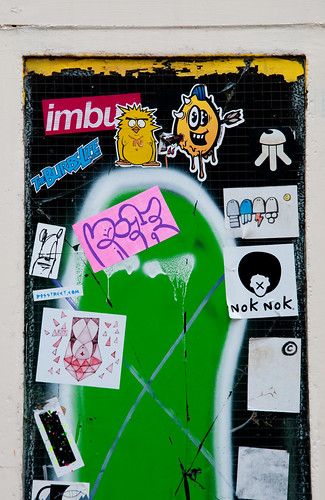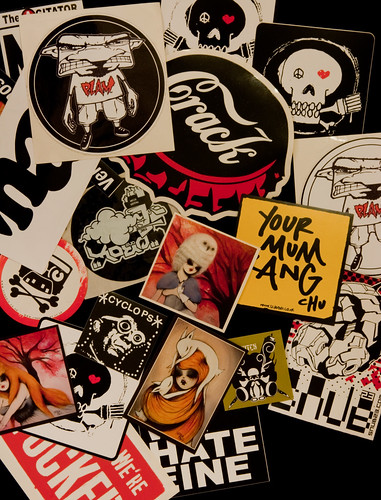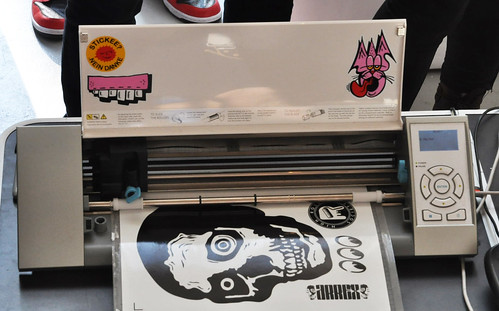10 Palmers Rd
London E2 0SY
25 March 2012
All photos: NolionsInEngland
Stickers photographed in the wild are by a variety of artists and are not all made by Stickee
Stickers operate at the margins of general acceptability, slightly less vilified than tagging by the “I love street art but tags are mindless vandalism” brigade. Stickering is a vital and vibrant culture where the graffiti’s “up and prolific” mindset fondles street art’s aversion to risk.
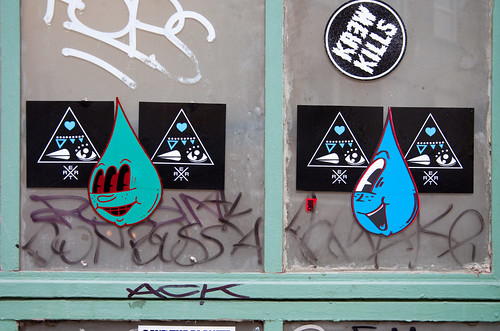
feat Nylon, printed by Stickee
High Roller Society took time from its hectic schedule to host a workshop by sticker maker Stickee. In the presence of some of London’s leading users of robust and permanent stickers, who understandably shied towards anonymity on the fringes of the gathering, Stickee demonstrated how the gap between you and home production of top quality screen printed stickers is bridged with a bit of software and some low cost hardware, most of which you probably already own.
Stickering is a broad label so to put Stickee’s product in context, sticker “artists” get up using anything ranging from hand written courier labels with acres of lovely white space, check our 2011 novelty street stickering interview with wordy DHL label supremo Curly, lazer jet printed envelop labels, “my name is” stickers to hi end multi-colour giclee printed and shaped vinyl productions. Often a glance around the edges of a street art show might reveal a little pile of artist stickers filling the function of calling card, usually worth trousering a few of those whilst sinking a few of those free weird tasting Ukranian cyders (or whatever they are, often it becomes difficult to remember).
Stickee is a full time sticker maker and the quality of his product belies the slightly Heath Robinson ramshackle production line. Starting with the art work which is imported or scanned into illustrator, a black template is prepared including registration marks which are incredibly important for the shape cutting at the end. Working in the CMYK colour scheme the template is printed on to acetate which is then used to burn the silk screen. Eschewing the very expensive vacuum photo exposure unit, Stickee creates the screens using a duvet vacuum bag (£1!!) and piece of foam, a black tee shirt, a vacuum cleaner and 1 cigarette’s worth of free sunshine. The enemy of sharp imagery at this stage seems to be light sneaking around under the black areas of the acetate, Stickee gave loads of tips, does and dont’s and tricks to minimise the risk of producing a crap screen.

Printing the reversed image on acetate

Duvet Covers – not just for housewives

Burning the screen, vacuum holding good!

Rinsing photographic emulsion off the screen
After all that care and cautious processing to ensure a blemish free image with sharp edges, no dust specks, nothing missing, the fun and quick bit is slapping around the ink at the screen printing stage, we all got a fling at that. Curiously, while the objective of printing the acetate is to get as much black ink as possible out of the nozzle, the nature of the vinyl paper and the ink are such that you actually need to be quite sparing with the ink at the screen printing stage, who’d have thought?
Then there is the cutting, which is computer driven on a digital blade cutter, this actually cuts the sticker but not the backing paper behind, must be pretty sensitive and/or clever. This is where the registration marks on the sheet are very important so that the optical device on the print head can find out exactly where the image on the computer screen is located on the sheet of paper. Best way to be wowed by this precision cutting is to look at Stickee’s own youtube video below.
video by Stickee
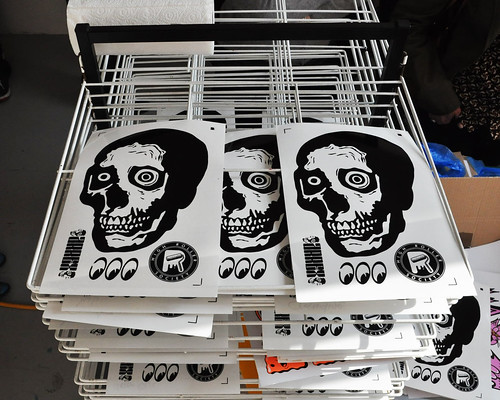
The Finished Product – main image attributed to ARREX
The gallery walls had a lush looking selection of various stickers produced by stickee, see below, as well as several intriguing “making of” demonstrators such as this collection showing the four screens used to produce the famous TEK 33 trident stickers.
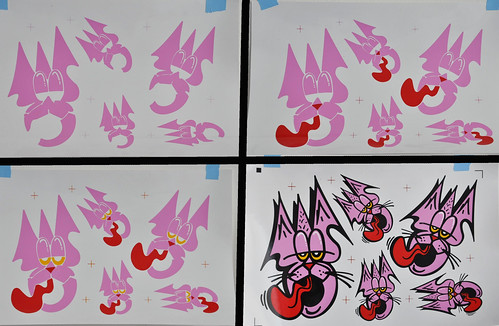
Top left to bottom right: pink layer, red layer, yellow layer, black layer
Like all these things, the technology is impressive and it is quite an eye opener to see the skill and length of time involved in producing even a single layer sticker. Anyone at the workshop could go home and have a fair stab at producing top quality stickers but as always the art is actually more important than the medium, so without a big flow of ideas probably your best bet is to let Stickee do it, Graffoto has known for a long time that his work is about the cheapest and highest quality!

Stickers by Mighty Mo, Aida, Nylon, Sweet Toof, Mr Penfold, Stickee, available from High Roller Society
Links:
Stickee Facebook
Stikee Flicker
High Roller Society
Arrex

